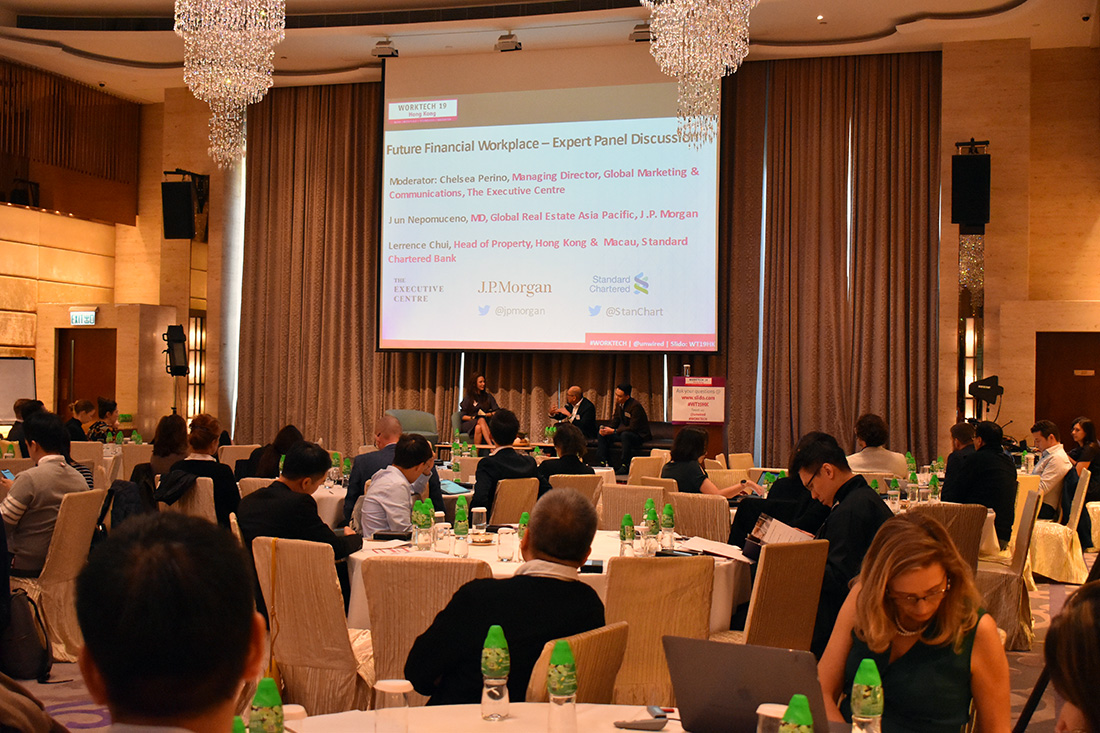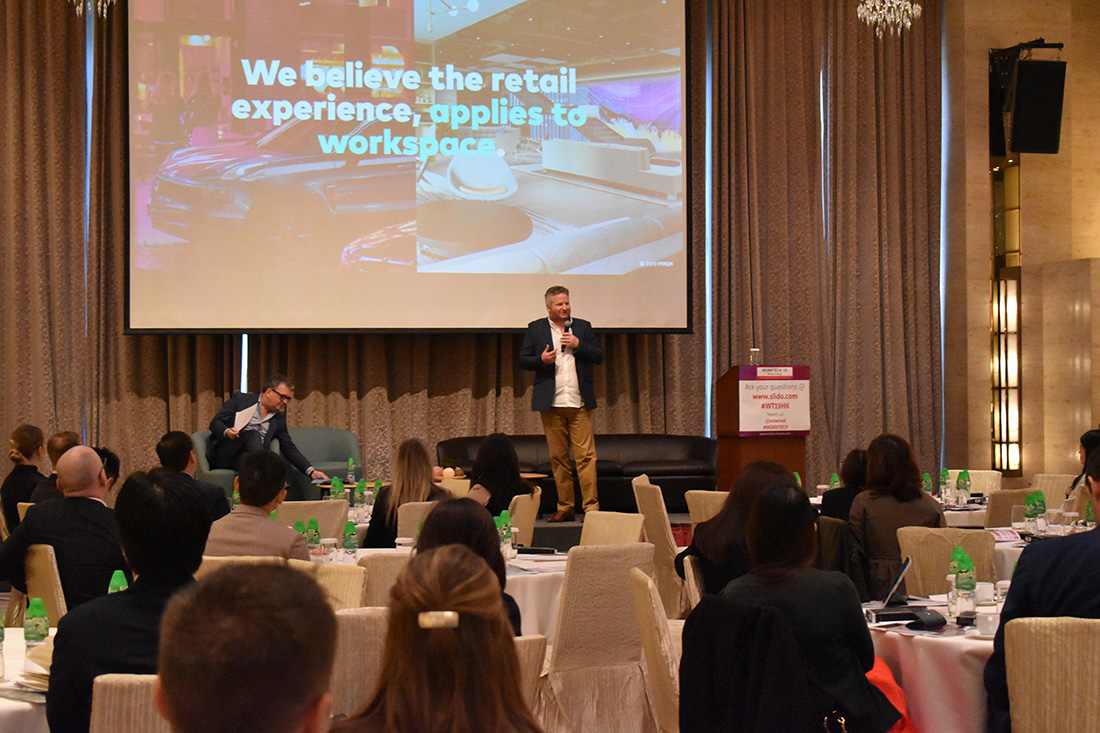WORKTECH 19 Hong Kong considered some of the key trends driving office space for the next decade – find out which ones.

January 8th, 2020
Autonomy, flexibility and experience: these were major themes at WORKTECH 19 Hong Kong, held on 4 December 2019 at the Harbour Grand Hong Kong Hotel. At this one-day conference, designers, strategists, technology experts, founders and other stakeholders came together to discuss what work and the workplace might look like in the future. Here are some of the directions they see for work in 2020 and beyond.

Last year’s WORKTECH 18 Hong Kong indicated we would see more companies moving towards flexible office arrangements, and the trend continues.
Samit Chopra, EVP Enterprise and Sales at International Workplace Group (IWG), presented the results of an IWG survey that demonstrated the pace of growth. Asia Pacific’s flex market has tripled in size in the last three years and it’s predicted to outpace the Americas in the next few years, he said. While flex space only accounts for 5 per cent of the global commercial real estate market right now, it’s set to grow to 30 per cent.
According to IWG’s survey, over 50 per cent of people work outside their main headquarters for at least half the week, and 75 per cent of the workforce works away from the office at least one day a week. In addition, 83 per cent of people worldwide would turn down a job that didn’t offer flexible working for one that does.
These findings echo Outpost’s experience in Bali and Cambodia. Delivering coworking and coliving space for global nomads, David Abraham – Outpost’s Co-founder – said the people coming through their spaces “value flexibility and that seamless lifestyle. Two-thirds of people want to shift their permanent hours,” he said.
As Abraham pointed out, people no longer want the corner office. “The questions then start to come in: what’s the purpose of the office, and are we meeting the needs of the people in it?”
Diversity will be the spice of life
The corner office is on the way out; so too are the rows of desks that have been the purview of offices since the 1950s. “The sea of desks doesn’t work,” said Uli Blum, Associate at Zaha Hadid Architects (ZHA), speaking about high-performance workspaces. “There’s no differentiation.”
Instead, he proposed a different vision: “A space that’s interconnected, self-evolving and has the ability to change, adapt and evolve from day-to-day … Maybe the office of the future also changes between seasons.”
Blum likened this workspace of the future to a city, where you have public and private spaces, roads, nice cafes and recognisable spaces, plus “large interconnected territories that allow teams to grow and shrink and change.”
Equally important is “diversity of density,” said Blum. “You might have very dense areas where you work intensively and then you might have areas that are separated not by walls, but by distance.”
Other speakers also raised the need for diversity in the workspace – in particular, Jonathan Cummings, Chairman of Greater China for Fitch, the brand and retail consultancy.
“So often I walk into offices and think, ‘This could be anywhere,’” said Cummings. He believes that, like retail spaces, however, workspaces should be the embodiment of a brand, with touchpoints that create an experience that cultivates employee engagement.
Experience was a keyword at WORKTECH 19 in Hong Kong. If employees are working in a space that is more experience-driven, it becomes more meaningful to them, said several of the speakers, noting that a dramatic shift is underway towards experiential workspaces.
This is not, said Cummings, a matter of simply installing a foosball table in your office. “From an emotional point of view, is it representative of what your brand stands for? Identify what the [workplace] experience needs to be to create that sense of belonging,” he said.

Cummings wasn’t the only one to speak about experience; Mathew Toniolo, Workplace Advisor at Haworth, also spoke about experience, offering solutions to the current challenge: how does a global organisation with a number of different offices in different cities create an engaging, collaborative, inspiring and above all consistent experience for those who use their spaces?
First, he said, consider “What problems are we trying to solve? Start here, and then start looking at the data.”
By analysing data, said Toniolo, you can understand how people are behaving in your spaces. Once you can understand this, you can establish the structure for your space based on your data. Then you can design workspaces that work – spaces that offer meaningful experiences to those who work there, that are consistent, and that can pivot, grow or shrink.
Whether you’re problem-solving, gathering data, designing or building workspaces, or seeing how well they operate, technology has a role to play.
Zaha Hadid’s Blum explained how their studio is using computational tools and algorithms to understand workplace behaviours and create self-evolving workplaces that respond and adapt to these behaviours.
He referenced a Zaha Hadid exhibition, where they used smart cameras to measure movement patterns in space. “We learnt which exhibits were the most popular, where people dwelled, where they stayed and what they looked at,” he said.
It’s a method that can be applied to workspaces as much as it can to exhibitions. “Understanding patterns of use allows us to understand what’s needed, and it allows the space to respond to the user,” said Blum.
While tech can help us create better user experiences, we have to see tech as the enabler, not the showpiece, said workplace technology strategist Patrick Stewart-Blacker in conversation with Wayne Cheung of Creston about Technology to Connect People and Space.
Another challenge with tech is cybersecurity: the perimeterisation of the Internet of Things within workplaces is restricting the application of other platforms that might enhance productivity and operational efficiency. How, then, can you balance security with the benefits of tech?
Workplace wellness was another hot topic at this year’s WORKTECH 19 in Hong Kong. As Chopra pointed out, the corporate employee wellbeing industry is gearing up to be a US$90 billion industry over the next seven years.
Many companies now recognise the value of creating workspaces that cater to their users’ mental, emotional and physical wellbeing – and Cook Medical is one of these. They tasked M Moser with helping them create a new, healthy Hong Kong office, taking into account the criteria that inform the WELL and RESET certifications.
Christine Bruckner, Global Head of Wellness, Health & Sustainability at M Moser and Theo Wong, Office Manager & APAC Marketing Manager at Cook Medical talked about how they tackled factors such as air, water, nourishment, comfort, fitness, community, greenery and light in Cook Medical’s new space.
According to Bruckner, studies show that we need four hours of daylight per day in order to maintain our health. For Cook Medical’s offices, they placed people next to windows wherever possible, giving them blinds they could lower and raise themselves depending on their needs.
A key benefit of the new office is the way in which it empowers the user to take responsibility for their own workplace experience, and their own wellbeing. Said Bruckner, “Asking people what they want is so important.”
A searchable and comprehensive guide for specifying leading products and their suppliers
Keep up to date with the latest and greatest from our industry BFF's!

Marylou Cafaro’s first trendjournal sparked a powerful, decades-long movement in joinery designs and finishes which eventually saw Australian design develop its independence and characteristic style. Now, polytec offers all-new insights into the future of Australian design.

In the pursuit of an uplifting synergy between the inner world and the surrounding environment, internationally acclaimed Interior Architect and Designer Lorena Gaxiola transform the vibration of the auspicious number ‘8’ into mesmerising artistry alongside the Feltex design team, brought to you by GH Commercial.

Channelling the enchanting ambience of the Caffè Greco in Rome, Budapest’s historic Gerbeaud, and Grossi Florentino in Melbourne, Ross Didier’s new collection evokes the designer’s affinity for café experience, while delivering refined seating for contemporary hospitality interiors.

Simon Liley, Principal Sustainability Consultant at Cundall, writes about how cyberpunk dystopias haven’t (quite) come to pass yet – and how designers can avoid them.

Focusing on facade and green design, this pair of office blocks is designed to meet the most contemporary demands of workplace design.
The internet never sleeps! Here's the stuff you might have missed

London-based Carmody Groarke and Paris-based TVK have been announced as winners of a milestone competition for the new Bibliothèque nationale de France conservation centre.

The Australian Design Centre (ADC) this year celebrates 60 years! A series of events are coming up to mark the occasion.